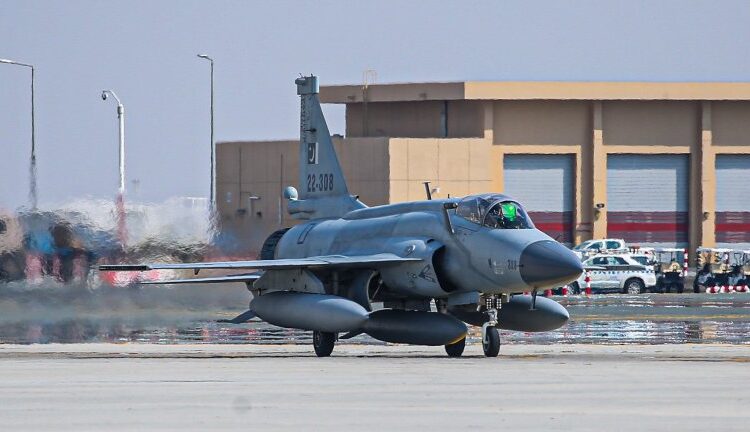Table of Contents
Tejas vs. Thunder: India and China Compete for Fighter Jet Deal with Nigeria
Indian Light Combat Aircraft (LCA) “Tejas” and Chinese JF-17 “Thunder” are competing to deliver fighter jets to Nigeria, having lost to an F-16 last time out.
Thank you for reading this post, don't forget to subscribe!S. Jaishankar, India’s minister of external affairs, recently travelled to Nigeria to support India’s offer of an indigenous fighter jet in the face of fierce competition from a Chinese warplane.
Image source: Eurasian Times
China is promoting the JF-17 in response to India’s promise to provide the African nation with Light Combat Aircraft (LCA) Tejas. India is aggressively selling the domestic fighter plane to land its first purchase.
The Eurasian Times was informed by an official with knowledge of the development that the subject matter was discussed during the Indian Foreign Minister’s just-finished visit to Nigeria.
Nigeria’s Fighter Jet Dilemma: Choosing Between JF-17 Thunder and LCA Tejas
The officer said, “The JF-17 representatives are already there.”
Nigeria wants to buy fifteen fighter jets to replace its ageing Chengdu F-7NI fleet. The Chinese offer has an unstated advantage due to their current fleet of combat fighters. The JF-17 “Thunder” and the LCA “Tejas” (Brilliance) are both single-engine, multipurpose combat aircraft.
India has been promoting defence exports with a zeal hitherto unheard of. In December 2023, Indian Finance Minister Nirmala Sitharaman predicted that the nation’s defence exports would reach $2.88 billion (about Rs 24,000 crore) in the 2024 fiscal year.
India’s Tejas Fighter Jet Advances as Talks With Nigeria Continue
In December 2023, CB Ananthkrishnan, Chairman of Hindustan Aeronautics Limited (HAL), an Indian aerospace manufacturer, said that talks with Nigeria were still underway.
LCA “Tejas” has advanced significantly since its inception. The Indian Air Force (IAF), which has added the aircraft to its inventory and will soon be deploying them on its advanced stations on the western front with Pakistan, is rapidly relying on these aircraft.
.According to reports, Tejas will shortly be placed in operational positions in the northern sector, where, in the event of a conflict between these two nations, it will have to engage in one-on-one combat with Pakistan’s F-16s and the China-Pakistan Joint Venture JF-17.
India has thrown diplomatic support behind it to sell Tejas to Argentina. However, the US was forced to sell the South American nation-used F-16s because of unease about the prospect of a Chinese fighter jet in its vicinity.
It is a given that the US fighter plane has stolen the contract, even if the recently elected government has not released an official statement.
Image source: Eurasian Times
The Indian delegates would not wish to be caught off guard by the Chinese “Thunder.” Three JF-17s are currently in service with the Nigerian Air Force, which is up against numerous obstacles such as piracy, violence within communities, separatist movements, and the Islamist militant group Boko Haram. In 2021, the JF-17s were inducted.
Nigeria’s air force, with only 15,000 personnel and 150 aircraft, is in dire need of modernization. The International Institute for Strategic Studies claims that old or outdated aircraft, such as the Alpha Jet, F-7, and MiG-21, make up the bulk of Nigeria’s air force inventory.
In addition, the Wing Loong II Chinese Unmanned Aerial Vehicle is operated by the Nigerian Air Force.
Advantages Tejas Has Over JF-17-
The Indian side has not wasted any time in highlighting how much more serviceable Tejas is than JF-17s. The LCA has a serviceability of more than 75% in the IAF squadron.
“At least 40 JF-17 aircraft out of the 100 delivered to date are known to be unserviceable. There have been a dreadful number of “incidents” in Pakistan and Myanmar. In contrast, the LCA has a flawless accident history and exceptional serviceability, as confirmed by an official who spoke with the EurAsian Times.
Another parameter that sets LCA one notch up the JF-17 is the fly-by-wire system. The JF-17 has a triplex redundant fly-by-wire system, and the LCA has a quadruplex redundant architecture.
Honing Tejas’ Brilliance
As seen by the recent deployment of a squadron for training to Awantipur in Jammu and Kashmir, the IAF has already started dispatching its two current LCA squadrons on detachments to forward air stations around the western and northern borders. The Tejas’s greatest shortcoming to date has been that it is a peacetime combat jet due to its deployment on the Indian peninsula; it has never been put to the test in battle.
However, this might all change if Tejas is stationed permanently at one of India’s forward air bases, which face either the west or the north and is required to monitor the skies over the country’s two strategically significant frontiers.
After being developed in the 1980s, the LCA is presently being used by the Indian Air Force (IAF) to replace its ageing fleet of MiG-21s built in the Soviet era. It is anticipated that the final MiG-21 unit will be phased out in 2025.
In 2021, the military placed an order for 83 LCA Mk1A aircraft with the state-owned Hindustan Aeronautics Limited (HAL). This order for 90 further aircraft will be placed with HAL. The IAF will have forty LCA, more than 180 LCA MK 1A, and at least 120 LCA MK-2 fighter jets once both orders are carried out within the following fifteen years.
- FASTag KYC update: Updation of KYC for FASTag before 31st January; Step-by-step Process:
- Tejas vs. Thunder: China’s “Wrestles,” JF-17 With a fighter deal with Nigeria, India’s LCA Tejas is fully engaged in backchannel diplomacy.
- Real Madrid Victory: At Las Palmas, Aurelian Tchouameni gives Real Madrid a late victory.
- Bharat Ratna: Must-know Facts and Important FAQs on the Bharat Ratna Award
- Klopp is leaving Liverpool at the end of the season
